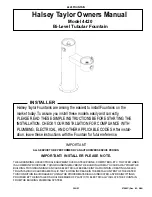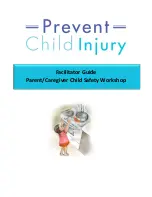
EngliSH | 25
4. Packaging, Transport and Storage
4.1. Delivery
After receipt, the shipment must be checked for damage
and completeness immediately. In the event of any de-
ficiencies, the transport company and the manufacturer
must be informed on the day of receipt, as no claims can
otherwise be made or considered valid. Any damage must
be noted on the delivery or transport receipt.
4.2. Transport
Do not throw or tip the lifting unit during transport.
Make sure that the lifting unit does not come into con-
tact with sharp edges. Protect the lifting unit from heavy
blows. The products are shipped in suitable packaging
by the manufacturer or supplier. This generally excludes
damage during transport and storage. Should you change
locations frequently, save the packaging carefully for re-
use.
4.3. Storage
Newly delivered products are prepared for up to 1 year of
storage. If the product is being placed in interim storage, it
must be thoroughly cleaned before being stored!
The following must be observed for storage:
•
Place product securely on a fixed base and secure
against tipping over.
•
In addition, ensure that the equipment is stored in
dry areas.
•
Products with vacuum and/or pressure connections
must have these tightly closed to prevent contami-
nation.
•
During extended storage the shaft must be protected
against moisture, sunlight, heat and frost.
If you observe these regulations, your product can be
stored for a longer period of time. However, note that the
elastomer parts and coatings are subject to natural em-
brittlement.
4.4. Materials returned
Products that are returned to the factory must be clean
and correctly packaged. „Clean“ means that the product
has been cleaned of contaminations and that it has been
contaminated in the event of use with mediums that are
hazardous to health. The packaging must protect the prod-
uct from damage. Please contact the manufacturer before
returning the product.
5. Installation and commissioning
5.1. General
The following points must be noted to prevent damages
in the lifting device during installation and commissioning:
•
The installation work must be carried out by qualified
personnel in compliance with the safety regulations.
•
The lifting device must be checked for possible dam-
ages prior to installation.
•
The minimum submersion in water must be consid-
ered for level control.
•
Protect the pump from frost.
•
The power lines of the pump must run in a way that
hazard-free operation and easy assembly/disassem-
bly is possible.
•
A dry run is strictly prohibited. We recommend level
control for this.
5.2. Fitting
Consequential damages, for example, due to flooding
of areas with problems at the pump, must be exclud-
ed by the operator with suitable counter measures
(e.g. alarm system installation, spare pump, etc.).
The lifting unit must be installed so that the lid can be
opened. Be sure to allow sufficient space between
the vertical/horizontal inlets and existing walls.
Drainage facilities whose lowest point of the odor
trip is deeper than 180 mm from the lower edge of the
lifting unit must be connected to the system via a
suitable pipe loop at least 180 mm long in accordance
with the standards. See installation examples!
All civil engineering, concrete and masonry work and
electrical connections must be carried out by spe-
cialist qualified in accordance with union regula-
tions. The shaft opening must be provided with a
slip-resistant cover after the pump has been in-
stalled.
Directly under the pressure outlet of the pump or in
the installation kit (depending on the pump type)
there may be a small drill hole. This drill hole serves
the better ventilation of the pump.
Summary of Contents for C250WA
Page 33: ...English 33 Notizen Notes ...
Page 65: ...Nedlerlands 65 Notizen Notes ...
Page 70: ...70 Notizen Notes ...
Page 71: ...71 Notizen Notes ...
















































